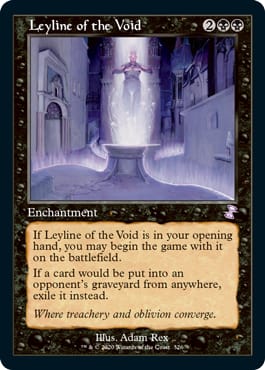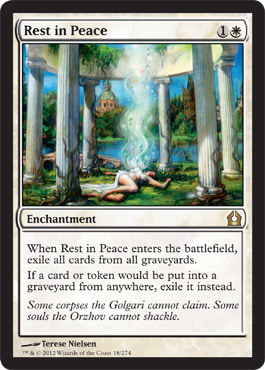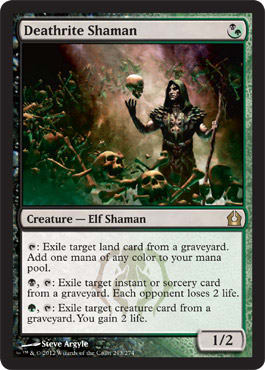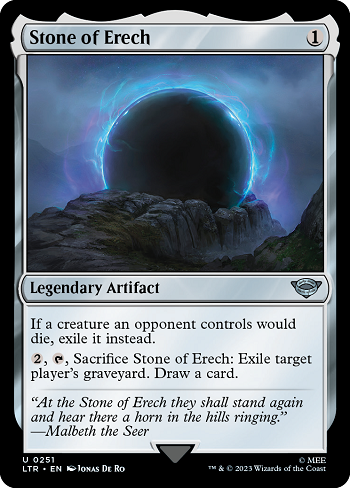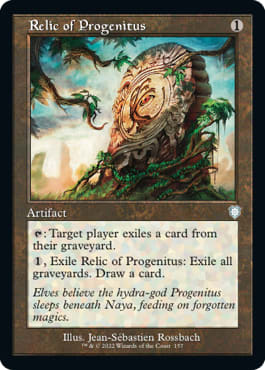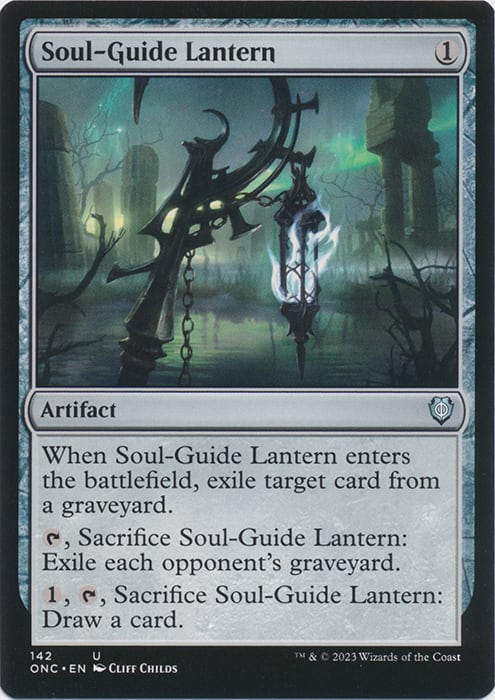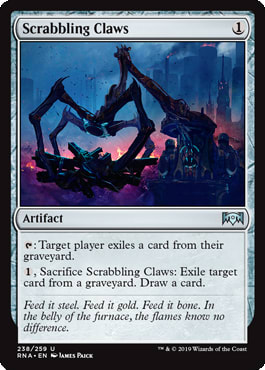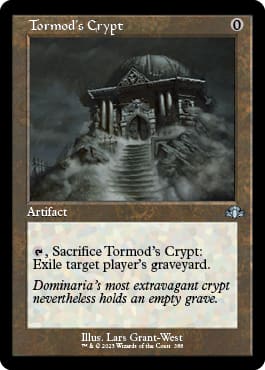Playing Magic utilizes a large number of different resources to manage. Most people tend to think of these in three basic ways: the lands you can control (and in turn the mana you can generate), cards in your library, and cards in your hand. After all, when you first learn how to play the game, these are the basic things you need to really care about. Then, the more you play, you slowly start to discover other resources and concepts as well. Things like your life being a resource, the importance of card advantage resources, and board presence. Then there's the graveyard.
If you're reading this article, you probably know the saying by now: your graveyard is, in many ways, just a second hand. This is primarily due to the existence of a large number of recursion abilities, including reanimation spells or more Raise Dead and Regrowth types of spells. This doesn't always just include spells, either, as you also get self-reanimating creatures like Bloodghast, Gravecrawler, and Vengevine. Even more notably, there has been a rise in spells that could just cast themselves from the graveyard, either via something like Flashback or Aftermath, or else have another spell cast them (Halo Forager, for example).
Thanks to the utility of the graveyard, there have been many cards over the years whose main purpose is to fight against the graveyard. You probably know several of them. Few - barring the likes of, say, multi-format all-star Deathrite Shaman - end up making appearances in the main deck, usually being relegated more to the sideboard. This is where you might see an opponent bring in several copies of something like Leyline of the Void to deal with powerful graveyard centric archetypes like Dredge or Reanimator.
Today, though, I want to focus on a more specific angle of graveyard hate: artifacts. Why, you ask? Because I'm here to present you the latest piece of cheap artifacts going after the graveyard. Meet the latest in a long line of cards coming soon in Lord of the Rings: Tales of Middle-earth, Stone of Erech.
First and foremost, a big thanks as always to Wizards of the Coast for providing this free preview card. It's always exciting to get to talk with you all about the latest cards during various preview seasons and this one is no different. If anything, it's a little more special to me. One of my favorite childhood memories was getting to see The Fellowship of the Ring with my late uncle and my dad in late 2001, and the trilogy of films has remained among my favorites to this day. So, while I haven't read the books yet (they're in my audiobook queue at the moment), it's a delight to get to bring you a card from Lord of the Rings: Tales of Middle-earth.
As for the card itself, Stone of Erech is an interesting way to utilize graveyard hate in multiple formats. No doubt players will look at this card and their first thoughts will jump to long-time staples such as Relic of Progenitus and Soul-Guide Lantern, both of which can exile entire graveyards while simultaneously giving you the ability to draw a card in the process, replacing what you lose in the transaction. Both of these have seen tremendous competitive play in a variety of formats, filling similar roles but having different utility depending on the format and metagame.
What makes Stone of Erech stand out compared to both of these is three things. First, it's a legendary artifact. This means you can only have one in play at any given time. Admittedly, this isn't as much of a hindrance as it may initially seem, as you'll likely be playing only one or two copies in your sideboard and won't often have multiples in your hand, much like Relic and Lantern. Second, it doesn't exile individual cards. Lantern does take out a specific card once, while Relic gives your opponent the choice, but does so over and over. Finally, there's the critical first ability: exiling opponents' creatures when they die.
This one feels particularly unique. When it comes to large graveyard hate abilities I tend to think of them in two ways: exiling the whole graveyard in one shot - like Stone of Erech's backside - or exiling anything when it hits the graveyard from anywhere, like with Leyline of the Void and Rest in Peace. Here, though, the Stone exiles creatures only when they leave the battlefield. This ends up being quite a limiter on what you'll end up hitting. It's not exactly going to stop the likes of powerhouse archetypes like Dredge or Reanimator, as those cards enter the graveyard from the deck or hand as opposed to the battlefield.
Where this works strongest is against decks that seek to sacrifice creatures over and over again. A big reason Hogaak decks were so strong, for example, was that you could sacrifice Hogaak over and over again to Altar of Dementia and mill opponents out while still having a large board in the process. Another recently memorable example might be the various Cat Oven decks that utilized the looping of Cauldron Familiar and Witch's Oven. Sacrifice is ever a popular staple strategy of Commander as well, which this can shut down handily and still offer a stronger burst of graveyard hate in a pinch. Perhaps most importantly, though, is the fact that it can stop one of Modern's most popular decks: Golgari Yawgmoth - a deck that heavily utilizes creature sacrifice to win the game.
It's interesting to see how far we've come in terms of graveyard hate over the years now. While the original one from The Dark - Tormod's Crypt - remains a staple of tournament play even today, many others of the time are almost stunning for how bad they look today. It's almost hard to believe that cards like Phyrexian Furnace and Thran Foundry saw serious competitive play as premier graveyard removal options, but they sure were! In fact, I distinctly remember during the first year of playing the game, my sibling and I acquired a pair of 1999 Worlds decks (Kai Budde and Mark Le Pine) and saw four copies of this in the sideboard of Le Pine's list. The weird Scrabbling Claws saw a bit of play back in the day - and even in its more modern release during Ravnica Allegiance - and a few years later, Relic of Progenitus would become one of the best options available.
There have been a few additional mass exile effects over the years fulfilling roles much like Tormod's Crypt and Relic of Progenitus. Nihil Spellbomb was immediately popular at the time of its release for its ability to be a quick-shot full one-sided exile like Crypt but giving you the option to draw a card if you're willing to pay a little extra. Cranial Archive also provided a familiar means of mass hate, taking the Thran Foundry approach but also giving you a cantrip. Crook of Condemnation was like a sort of nerfed Relic of Progenitus and Sentinel Totem was yet another Tormod's Crypt effect that gave you a dash of library manipulation for your mana. Each of these saw notable amounts of play in their time, though each - with the exception of the Spellbomb - have largely been lost to time.
Finally, we get to the somewhat more niche and narrow approaches, much like what Stone of Erech is trying to do here by hating creature sacrificing. Grafdigger's Cage was arguably the first of this style, preventing creatures from entering the battlefield from your graveyard as well as your library, nor could you cast spells from the graveyard. This targeted Zombies and Flashback at the time, and has proven to be a staple of non-rotating formats. It was even expanded to include nonland cards being unable to enter the battlefield this way with Weathered Runestone in Kaldheim. In a very similar vein, there was also Silent Gravestone, which can exile everything and cantrip, but uniquely stops cards in graveyards from being targeted - the only ability of its kind much like how Stone of Erech is now.
So how will Stone of Erech line up in a world of such powerful and efficient graveyard hate? It's hard to tell just yet. It's a powerful effect that comes down cheaply. Unlike Silent Gravestone, the secondary mass exile ability is also quite cheap, so even if its front side isn't always going to prove the most useful in every situation, it's far easier to utilize the back half instead. The fact remains, though, that it's fighting for sideboard space in a world where Relic of Progenitus, Tormod's Crypt, Soul-Guide Lantern, Grafdigger's Cage, and even Unlicensed Hearse exist. Couple that with the utility of Leyline of the Void, Rest in Peace, Scavenging Ooze, Lion Sash, and even Graveyard Trespasser // Graveyard Glutton and it becomes that much harder to justify running this over the competition.
Still, the unique utility makes it an appealing option. In certain playgroups and metagames, it's likely going to be worth running. Lots of sacrifice going around? You might want to give this one a try! Heck, if this were to ever make it down to common, it's not a bad option against the Goblin Combo deck that relies heavily on a creature sacrifice combo loop to win you the game. In the end, it's a fine choice in a long line of playable ways to deal with problematic graveyard strategies. Will you use this stone to secure your victory, or will it be left to the ages as a forgotten relic in the myths of days yet to come? Only time will tell, but I can't wait to see what impact it ends up leaving on the game of Magic as a whole!
















